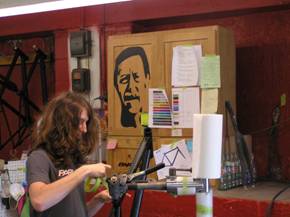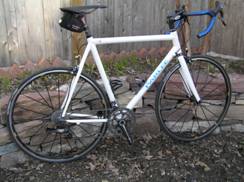Parlee Factory Tour
PARLEE FACTORY TOUR
By Jim Weaver, Service Manager
Fit Werx, VT
My wife had to make another trip to Boston to visit the harp retail and repair store in Salem. So, I tagged along to take the opportunity to visit the Parlee factory in Beverly, MA. I had visited the factory about 1 1/2 years ago, but another opportunity was not to be missed. This article is not intended as an in-depth review of how Parlee manufactures bikes. There have been several very good articles on this point, such as Bike Radar’s article at https://www.bikerumor.com/2012/04/12/factory-tour-parlee-cycles-part-1-inside-look-at-how-t they-make-custom-carbon-fiber-bikes, or Bicycling Magazine’s article at https://www.bicycling.com/bikes-gear/bikes-and-gear-features/making-custom-carbon-fiber-road-bike-tour-parlee-cycles. This is simply my impressions of how they go about designing and building what I feel are some of the best riding bikes available anywhere.
If you have not already done so, you should read the description in our website of Parlee, and why we carry Parlee bicycles, at https://fitwerx.com/product-reviews/bike-frame-manufacturer-profiles/parlee. Briefly, Parlee manufactures full carbon fiber frames. Design, prototype construction, manufacturing of small parts, and construction of custom-built frames, takes place in Parlee’s Beverly, MA facility. Bob Parlee came from the carbon fiber yacht industry. He was a cyclist, and wanted a carbon fiber bike, but with his knowledge of carbon fiber, he was dissatisfied with all of the various offerings on the market. In 1999, he finally decided to apply his extensive knowledge of carbon fiber to the actual construction of bicycles, setting out to build a frame that met his standards of quality, performance, and weight, rolling his own carbon fiber tube, and experimenting until he was satisfied. His efforts drew the attention of local riders, including the likes of Tyler Hamilton, and he started shipping customer bikes in 2001. Outgrowing his very limited facilities, Bob moved production to a site in Peabody, MA, coincidentally just a few blocks down the street from our MA location. Parlee continued to grow, eventually also outgrowing the Peabody location, and moved to the current Beverly location.
 As the business grew, Bob and his growing staff could no longer keep up with actual tube fabrication. Parlee found manufacturers who could produce the carbon fiber tubing to Parlee’s exacting specifications and the carbon tubing is now sourced from ENVE, as are most of the forks supplied with Parlee bikes. The tubing for the Parlee Z1, Z2 and Z3 road frames is comprised of traditional-looking round, straight tubing. The individual tubes are mitered at the intersections to fit exactly. No filler is used to fill gaps, because the tubes are mitered to fit perfectly. The tubing intersections are then wrapped with carbon fiber so that the frames look like they are made with carbon fiber lugs, like a Serotta, but they are not. This manner of joining the tubing gives Parlee more flexibility in manufacturing frames to a rider’s specific geometry needs than is possible from a true lugged frame, for the design is not constrained by the angles allowed by carbon lugs. This technology also helps give Parlee bikes their distinctive ride quality. A proprietary silicone mold is used for curing these joints. Parlee uses tubing manufactured to five different specifications, offering different ride qualities. These different tubes are then mixed and matched in the construction of a frame to produce the ride qualities that serve the individual rider of the frame best.
As the business grew, Bob and his growing staff could no longer keep up with actual tube fabrication. Parlee found manufacturers who could produce the carbon fiber tubing to Parlee’s exacting specifications and the carbon tubing is now sourced from ENVE, as are most of the forks supplied with Parlee bikes. The tubing for the Parlee Z1, Z2 and Z3 road frames is comprised of traditional-looking round, straight tubing. The individual tubes are mitered at the intersections to fit exactly. No filler is used to fill gaps, because the tubes are mitered to fit perfectly. The tubing intersections are then wrapped with carbon fiber so that the frames look like they are made with carbon fiber lugs, like a Serotta, but they are not. This manner of joining the tubing gives Parlee more flexibility in manufacturing frames to a rider’s specific geometry needs than is possible from a true lugged frame, for the design is not constrained by the angles allowed by carbon lugs. This technology also helps give Parlee bikes their distinctive ride quality. A proprietary silicone mold is used for curing these joints. Parlee uses tubing manufactured to five different specifications, offering different ride qualities. These different tubes are then mixed and matched in the construction of a frame to produce the ride qualities that serve the individual rider of the frame best.
The forthcoming custom Z-Zero is made in a different manner. The individual tubes are not made from wraps of carbon fiber, but rather are bladder molded. The tubes are not strictly round, as with the Z1, 2 and 3. For example, the top tube is a bit ovalized. The tubing is still straight, reflecting Bob’s belief that this is the strongest tubing shape. The Z-Zero is being specifically designed to accommodate internal Di2/EPS electronic shifting cabling. If desired, the Z-Zero will also be able to accommodate disk brakes and the frameset will be even stiffer lighter than the already very stiff and light Z1.
Parlee also offers the Z5, a stock-geometry full carbon fiber road bicycle. This bicycle is not made in the US, but rather in a special carbon manufacturing facility in South Korea. Parlee specifies the exact carbon lay-up for these frames, and these monocoque frames are manufactured to a standard of quality and finish that are virtually indistinguishable from the custom Parlees. Finally, Parlee also manufactures the custom-built TT, and the stock-geometry TT, both triathlon/time trial bikes. We have many clients riding the stock-geometry TT, and last I wrote about my choice of a Parlee TT for myself last fall, and the reasons for that choice, at https://fitwerx.com/category/new-bike-technology/page/4. Bruce has also since acquired one for his time trial exploits, so you can see that we really like that frameset here at Fit Werx.
My wife and I were warmly greeted by company founder Bob Parlee and his wife Isabelle. Unfortunately, many of the bikes and frames that were usually in their showroom were “out on tour”, being shown at shows and to bike shops. We did get a chance to see the new Z-Zero frameset that was recently introduced to the public at Interbike though. After a pleasant chat with Bob and Isabelle, we were introduced to Tom Rodi who took over as our tour guide. Tom has been with Parlee for many years, now serving in the capacity of Director of Sales and Marketing.
Tom Rodi explained that Bob Parlee’s attitude is to do more with less, to attain a balance of durability, weight, speed, ride quality, and stiffness. These qualities may seem to be hard to meld into one frame. How can a frame be both lightweight and durable? Many lightweight frames a re, well, not necessarily so durable. How can a frame be both stiff while offering superior ride quality? Stiffness often means a rough ride. How do you do all of these things at once, while also tuning the ride to the customer’s specifications? These seemingly incongruous goals are achieved through constant development and experimentation, in the hands of the carbon expert whose name is on the downtube. While some manufacturers have moved towards swoopy or elaborately shaped tubing, or inserts of various types in the tubing, to try to meet the seemingly contradictory goals outlines above, Parlee does not do this. Parlee views such shapes at best as a replacement for true quality carbon engineering, and, at worst, simply marketing. Parlee road bikes retain the traditional round, straight tubing. Why? As Tom explained to us, the actual fibers that make up the carbon fiber sheets used to make carbon fiber products are straight, not curvy. These individual fibers therefore bear force in a straight line. Straight tubing is more efficient, and can be made lighter as a result. Compared to some of the curvy, sometimes elaborate shapes seemingly in vogue in the bike industry, the same, or better, ride quality and strength can be achieved, at less weight, through proper design and engineering of straight tubing. Simply because carbon may allow fancy shapes does not mean that those shapes are better. That is simply marketing. Again, do more with less.
re, well, not necessarily so durable. How can a frame be both stiff while offering superior ride quality? Stiffness often means a rough ride. How do you do all of these things at once, while also tuning the ride to the customer’s specifications? These seemingly incongruous goals are achieved through constant development and experimentation, in the hands of the carbon expert whose name is on the downtube. While some manufacturers have moved towards swoopy or elaborately shaped tubing, or inserts of various types in the tubing, to try to meet the seemingly contradictory goals outlines above, Parlee does not do this. Parlee views such shapes at best as a replacement for true quality carbon engineering, and, at worst, simply marketing. Parlee road bikes retain the traditional round, straight tubing. Why? As Tom explained to us, the actual fibers that make up the carbon fiber sheets used to make carbon fiber products are straight, not curvy. These individual fibers therefore bear force in a straight line. Straight tubing is more efficient, and can be made lighter as a result. Compared to some of the curvy, sometimes elaborate shapes seemingly in vogue in the bike industry, the same, or better, ride quality and strength can be achieved, at less weight, through proper design and engineering of straight tubing. Simply because carbon may allow fancy shapes does not mean that those shapes are better. That is simply marketing. Again, do more with less.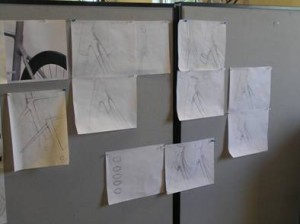
We started our tour at what amounts to Bob Parlee’s workbench in the factory, where he works on the design of new bikes. Bob is the principal designer for the company, so he is most definitely a “hands-on” company owner, actually being responsible for the design of the bikes his company produces. Computers are used in the design, of course, but so is free-hand drawing, and actually fabricating mock-ups out of a variety of materials before experimental parts are fabricated in-house out of carbon fiber. The bicycle industry is evolving rapidly, and resting on one’s laurels will quickly result in falling far, far behind – a frequent tendency among small “boutique” manufacturers. So, Parlee believes in constant innovation and development. This work space even included a mock-up of a new wing for Bob’s remote-controlled glider, trying to improve its aerodynamics. So, these people are not only experts at carbon fiber design and construction, but aerodynamics as well.
We had a chance to see many of the various departments in action, from fabrication of small parts, such as derailleur clamps out of “prepreg” 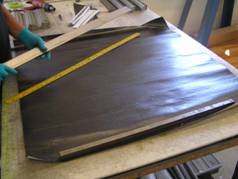 carbon fiber sheets, to frame construction, to deburring and frameset finishing, to painting. As an example of the finishing attention to detail, the logos on the frames are not decals, as with the vast majority of other bikes, but rather are painted on. They feel this allows the logo to be better scaled to the size of the bike frame. The employees at Parlee consider themselves as bicycle builders. They are neither machinists nor metal fabricators. Therefore, CNC machining of metal parts is done by a contractor in Essex, MA, another town in the Boston area, and titanium machining is done in California.
carbon fiber sheets, to frame construction, to deburring and frameset finishing, to painting. As an example of the finishing attention to detail, the logos on the frames are not decals, as with the vast majority of other bikes, but rather are painted on. They feel this allows the logo to be better scaled to the size of the bike frame. The employees at Parlee consider themselves as bicycle builders. They are neither machinists nor metal fabricators. Therefore, CNC machining of metal parts is done by a contractor in Essex, MA, another town in the Boston area, and titanium machining is done in California.
We saw work-in-progress for the design of a new UCI-compliant TT/Tri frameset incorporating a new fork to be produced internally by Parlee. This frameset should be available by the end of 2012. Work is also progressing on an aero-tubing equipped road bike frameset and a new non-UCI compliant deep profile triathlon bike should be forthcoming soon as well. The triathlon market is huge, particularly compared to the very limited market for bikes that must comply with the UCI’s rules, so, Parlee is moving in that direction, as are other manufacturers. Understandably, no detailed descriptions or pictures of any designs were allowed!
Big Brother Bob Parlee is watching!
Parlee is more than willing to accommodate requests for custom paint schemes, so you do not need to feel constrained by the paint program on their website. For example, a customer wanted to have pictures of iconic climbs he had ridden painted on the bike. So, after working with Parlee’s designers, the finished bike had these mountains painted on the top tube. If you can imagine it, in all likelihood, they can paint it.
At present, Parlee offers the Z-1, Z-2, and Z-3 in what Parlee terms a “semi-custom” configuration. There are a wide variety of frame sizes available in the semi-custom lines that should be able to meet practically ever rider’s geometry needs. However, if you want the very best, Parlee offers full custom designed framesets in the forthcoming Z-Zero, Z1, Z2, and Z3 designs. The Z5 comes in standard, SL and SLi configurations. The SL and SLi are lightweight versions of the already light Z5, and the SLi is designed and built to accommodate both Shimano Di2 and Campagnolo EPS internal wiring. As mentioned above, for time trialing and the triathlon market, Parlee offers the TT Custom, and the TT standard geometry frameset that Bruce and I like so much. Other options are also available, including a full carbon cross bike, a touring frameset, and a track design.
Parlee makes excellent bikes that combine everything that I want in a bicycle: a comfortable ride, quick and responsive handling while maintaining straight-line stability, and excellent stiffness for power transfer. That is why I have two of them, my aforementioned TT, and my road Z2. I am anxiously looking forward to building our first Z-Zero and getting a chance to give it a test ride! It was a pleasure to see how these bikes are designed, the detailed manner of their construction, the employees’ commitment to building what they feel are the best frames on the planet, and Parlee’s plans for the future. Not only do they make great bikes, but that excellence of design is being pushed into the future with new designs. I anxiously look forward to seeing these new designs come to fruition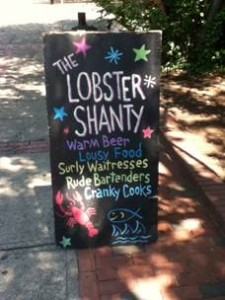
So, we bade goodbye to Tom, and Bob and Isabelle, and headed off from Beverly to Salem. Unfortunately we did not have time to visit the many educational attractions in Salem, such as the Salem Witch Museum, the Salem Witch Walk, Witch Dungeon Museum, Witch History Museum, Count Orlock’s Nightmare Gallery, the Nightmare Factory, and, well, you get the picture. History overdone, or rather exaggerated?. No comment on my wife’s choice of lunch stop…

